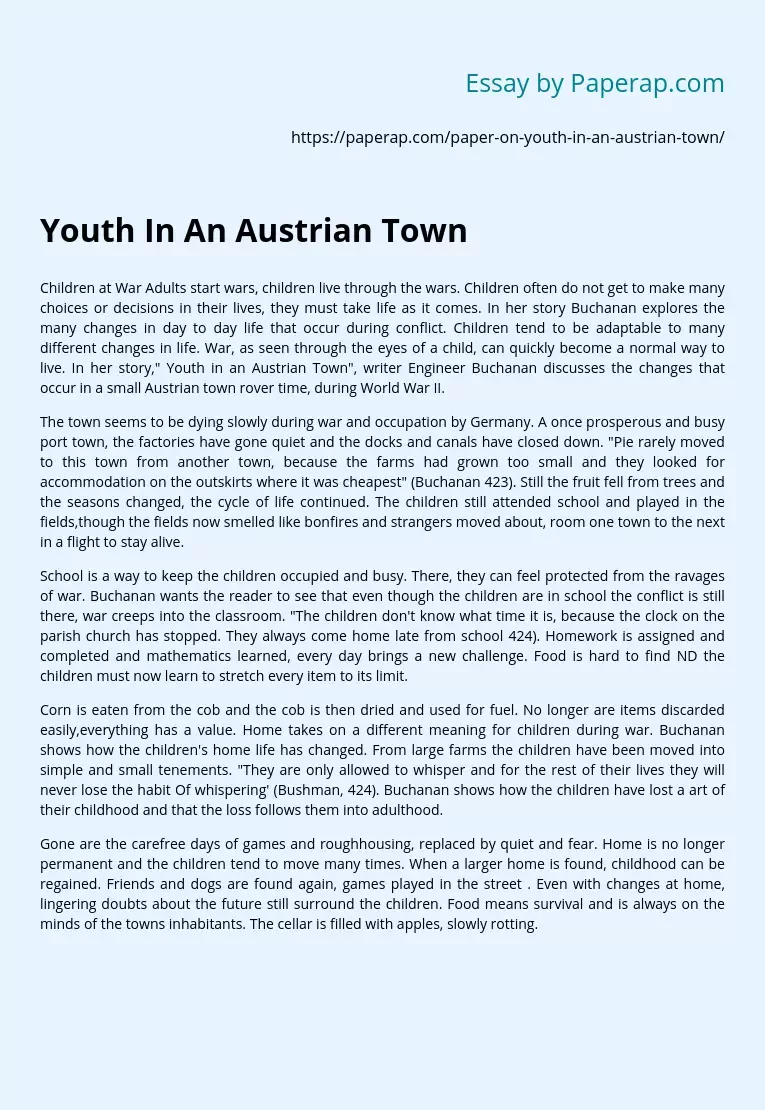Youth In An Austrian Town
Children at War Adults start wars, children live through the wars. Children often do not get to make many choices or decisions in their lives, they must take life as it comes. In her story Buchanan explores the many changes in day to day life that occur during conflict. Children tend to be adaptable to many different changes in life. War, as seen through the eyes of a child, can quickly become a normal way to live. In her story,” Youth in an Austrian Town”, writer Engineer Buchanan discusses the changes that occur in a small Austrian town rover time, during World War II.
The town seems to be dying slowly during war and occupation by Germany. A once prosperous and busy port town, the factories have gone quiet and the docks and canals have closed down. “Pie rarely moved to this town from another town, because the farms had grown too small and they looked for accommodation on the outskirts where it was cheapest” (Buchanan 423).
Still the fruit fell from trees and the seasons changed, the cycle of life continued. The children still attended school and played in the fields,though the fields now smelled like bonfires and strangers moved about, room one town to the next in a flight to stay alive.
School is a way to keep the children occupied and busy. There, they can feel protected from the ravages of war. Buchanan wants the reader to see that even though the children are in school the conflict is still there, war creeps into the classroom.
“The children don’t know what time it is, because the clock on the parish church has stopped. They always come home late from school 424). Homework is assigned and completed and mathematics learned, every day brings a new challenge. Food is hard to find ND the children must now learn to stretch every item to its limit.
Corn is eaten from the cob and the cob is then dried and used for fuel. No longer are items discarded easily,everything has a value. Home takes on a different meaning for children during war. Buchanan shows how the children’s home life has changed. From large farms the children have been moved into simple and small tenements. “They are only allowed to whisper and for the rest of their lives they will never lose the habit Of whispering’ (Bushman, 424). Buchanan shows how the children have lost a art of their childhood and that the loss follows them into adulthood.
Gone are the carefree days of games and roughhousing, replaced by quiet and fear. Home is no longer permanent and the children tend to move many times. When a larger home is found, childhood can be regained. Friends and dogs are found again, games played in the street . Even with changes at home, lingering doubts about the future still surround the children. Food means survival and is always on the minds of the towns inhabitants. The cellar is filled with apples, slowly rotting.
The apples are not thrown out, instead they are picked over and any apple or piece that can be saved and eaten is put aside and eaten. The children hunger for different fruits. Families grow food on the small plots of land allotted to them. “The children read their eyes sore” (Buchanan, 425). Escape in books is the children’s’ only escape from the daily war. Evenings are spent reading and dreaming of a life spent in Alaska or Sardinian. Conversations overheard are given new meanings and the children dream of a different world that they can be a part of.
Buchanan shows how books are a means of escape for the children. The children grasp at any diversion to keep the fear away. ” They laugh at every opportunity: they can scarcely contain themselves and fall off the bench for laughing so hard; get up and go on laughing, till they get cramps” (Buchanan,425) As the war around them escalates, the losses mount and the children mourn. Air raids sirens announce death coming on the horizon. The houses around them are disappearing, replaced by rubble. ” There is no more light in the house. No glass in the windows.
No door on the hinges. Nobody stirs and nobody rises” (Buchanan, 427). Buchanan draws a vivid picture of a city slowly crumbling, a town falling prey to the violence and war around them. Movie theaters turn into cemeteries as the rubble encloses the dead, unable to be dug out. The smell of death permeates the town and the children are again told to keep quiet to survive. One day peace comes to the town. Peace is not announced but the children feel the change. “Spring descends with clear, raging waters and gives birth to a blade of grass”(Buchanan,427).
Writer Bacchanal describes a town slowly coming back to life. Its citizens return and stores open once again. The town has survived the conflict, but will never be the the same. Gone are the easy memories of past , replaced with a new town square and monuments to those that have been lost, old mingles with new, like the waters in the sea. Buchanan shows how the children have survived but are forever changed.
Youth In An Austrian Town. (2018, Mar 27). Retrieved from https://paperap.com/paper-on-youth-in-an-austrian-town/

